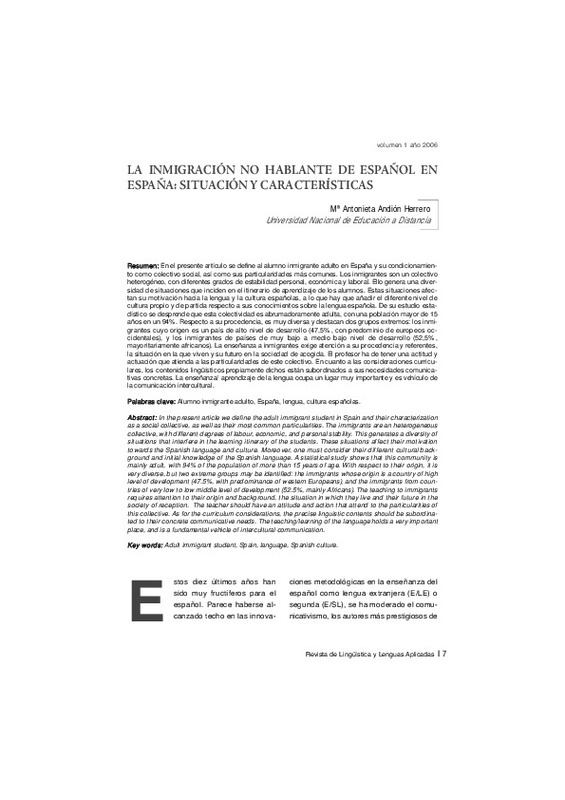|
Resumen:
|
[EN] In the present article we define the adult immigrant student in Spain and their characterization
as a social collective, as well as their most common particularities. The immigrants are an heterogeneous
collective, ...[+]
[EN] In the present article we define the adult immigrant student in Spain and their characterization
as a social collective, as well as their most common particularities. The immigrants are an heterogeneous
collective, with different degrees of labour, economic, and personal stability. This generates a diversity of
situations that interfere in the learning itinerary of the students. These situations affect their motivation
towards the Spanish language and culture. Moreover, one must consider their different cultural background
and initial knowledge of the Spanish language. A statistical study shows that this community is
mainly adult, with 94% of the population of more than 15 years of age. With respect to their origin, it is
very diverse, but two extreme groups may be identified: the immigrants whose origin is a country of high
level of development (47.5%, with predominance of western Europeans), and the immigrants from countries
of very low to low middle level of development (52.5%, mainly Africans). The teaching to immigrants
requires attention to their origin and background, the situation in which they live and their future in the
society of reception. The teacher should have an attitude and action that attend to the particularities of
this collective. As for the curriculum considerations, the precise linguistic contents should be subordinated
to their concrete communicative needs. The teaching/learning of the language holds a very important
place, and is a fundamental vehicle of intercultural communication.
[-]
[ES] En el presente artículo se define al alumno inmigrante adulto en España y su condicionamiento
como colectivo social, así como sus particularidades más comunes. Los inmigrantes son un colectivo
heterogéneo, con ...[+]
[ES] En el presente artículo se define al alumno inmigrante adulto en España y su condicionamiento
como colectivo social, así como sus particularidades más comunes. Los inmigrantes son un colectivo
heterogéneo, con diferentes grados de estabilidad personal, económica y laboral. Ello genera una diversidad
de situaciones que inciden en el itinerario de aprendizaje de los alumnos. Estas situaciones afectan
su motivación hacia la lengua y la cultura españolas, a lo que hay que añadir el diferente nivel de
cultura propio y de partida respecto a sus conocimientos sobre la lengua española. De su estudio estadístico
se desprende que esta colectividad es abrumadoramente adulta, con una población mayor de 15
años en un 94%. Respecto a su procedencia, es muy diversa y destacan dos grupos extremos: los inmigrantes
cuyo origen es un país de alto nivel de desarrollo (47,5%, con predominio de europeos occidentales),
y los inmigrantes de países de muy bajo a medio bajo nivel de desarrollo (52,5%,
mayoritariamente africanos). La enseñanza a inmigrantes exige atención a su procedencia y referentes,
la situación en la que viven y su futuro en la sociedad de acogida. El profesor ha de tener una actitud y
actuación que atienda a las particularidades de este colectivo. En cuanto a las consideraciones curriculares,
los contenidos lingüísticos propiamente dichos están subordinados a sus necesidades comunicativas
concretas. La enseñanza/ aprendizaje de la lengua ocupa un lugar muy importante y es vehículo de
la comunicación intercultural.
[-]
|








